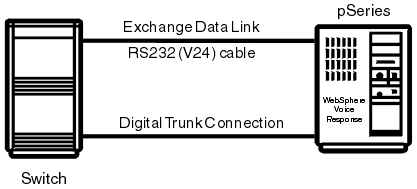This section introduces the connections you have to make to ensure that Blueworx Voice Response is connected to the telephone network:
Digital trunk connections
- The Digital Trunk Telephony Adapter (DTTA): full name IBM Quad Digital Trunk Telephony PCI Adapter.
Table 1 shows the maximum number of digital trunk adapters you can use in the currently supported system units.
| System p5, pSeries, or RS/6000 model | Maximum number of DTTAs |
|---|---|
| pSeries 615 Models 7029-6C3 and 6E3 | Three |
| pSeries 620 Models 7025-6F0 and 6F1 | Not supported |
| pSeries 630 Models 7028-6C4 and 6E4 | Four |
| pSeries 650 Model 7038-6M2 | Four |
| System p5-520 Model 9111-520 | Three |
| System p5-550 Model 9113-550 | Four |
| System p5-570 Model 9115-570 | Not supported, but see pSeries 7311-D20 I/O Drawer below |
| System p6-520 Model 8203-E4A | Two |
| System p6-550 Model 8204-E8A | Two |
| System p6-570 Model 9117-MMA | Not supported, but see next row |
| pSeries 7311-D20 I/O Drawer on System p6-520, p6-550, p6-570 | Four per i/o drawer |
| pSeries 7311-D20 I/O Drawer on System p5-520, p5-550 or p5-570 | Four per i/o drawer |
| pSeries 7311-D20 I/O Drawer on pSeries 650-6M2 | Four per i/o drawer |
| pSeries 7311-D20 I/O Drawer on pSeries 630-6C4 | Four per i/o drawer |
| pSeries 7311-D10 I/O Drawer on pSeries 650-6M2 | Three per i/o drawer |
| Intellistation 9114 Model 275 | One |
Blueworx Voice Response Version 6.1 also supports LPAR technology, to a maximum of two LPARs per pSeries using DTTA, or four LPARs per BladeCenter blade or pSeries using DTNA. For example, with LPARs the total number of DTTAs supported in a 7311-D20 drawer is increased to 7.
An appropriate allocation of CPU, memory, storage and Ethernet resources must be assigned to each Blueworx Voice Response LPAR. As a guideline, a system performance rPerf of 20 can support a 480-channel Blueworx Voice Response LPAR running speech-enabled VoiceXML applications. See http://www.ibm.com/systems/power/hardware/notices/rperf.html for further information on rPerf.
For the most recent information about adapter support, check the following Web page:
http://www.ibm.com/support/docview.wss?rs=761&uid=swg21253839
Each digital trunk adapter can support up to four trunk connections to the telephone network. Each trunk can carry 24 (T1) or 30 (E1) calls simultaneously.
- A direct T1 or E1 connection to the switch.
- A T1 or E1 connection to a channel bank connected to a switch.
- A T1 connection to a channel service unit (CSU) connected to the switch.
- A T1 connection to a CSU connected to a channel bank, connected to the switch.
Any one Blueworx Voice Response system can support either T1 or E1 connections, but not both. The necessary telecommunications cables are described in more detail in Digital interface cables for Blueworx Voice Response.
H.100 connections
The DTTA is an H.100 adapter. All H.100 adapters in a pSeries computer must be connected together using an H.100 top-connector cable. This is to synchronize the adapters and to support functions such as speech recognition and channel-to-channel connection (tromboning). H.100 is the industry standard for PCI systems.
- Adapters should be in adjacent slots in the system unit.
- The termination jumper must be set for the adapter at each end of the chain. For details see IBM Quad Digital Trunk Telephony PCI Adapter (DTTA): Installation and User's Guide.
No H.100 cables are supplied with the DTTA; you must order them, as described in Blueworx Voice Response for AIX: General Information and Planning.
The DTTA has an H.100 connector on the base card (nearest to the front of the pSeries computer).
Exchange data link connections
When using channel-associated signaling (CAS) to connect to some switches (including Avaya, Ericsson MD110, Nortel DMS, and Siemens Hicom), an exchange data link is required to carry signaling information. In all other cases, including ISDN, the signaling information is carried by the digital trunk connection and an exchange data link is not required.
- A direct connection (using the appropriate serial cable); see Figure 1. Figure 1. Exchange data link (direct connection)

- An indirect connection (using two modems); see Figure 2.
Use an indirect connection when:
- The distance between the pSeries computer and the switch exceeds the capabilities of your cable.
- You are connecting the pSeries computer to
a central office exchange; in these circumstances you should obtain
advice from your telephone network provider before following the instructions
given in this information. Figure 2. Exchange data link (indirect connection)

- Bisynchronous link
- This implementation supports the Siemens HiCom 300 interface, Application Connectivity Link (ACL), which requires a bisynchronous communications link between the switch and the pSeries computer.
- Asynchronous link
- This implementation supports:
- NORTEL's Simplified Message Desk Interface (SMDI)
- AT&T's Simplified Message Service Interface (SMSI)
- Ericsson's Voice Message Service (VMS)
You can also write your own signaling process to support an exchange data link (refer to the Blueworx Voice Response for AIX: Programming for the Signaling Interface information for details).
The Blueworx Voice Response for AIX: General Information and Planning information contains more information about using the exchange data link. This section explains how to physically connect the link. The equipment required and procedures to be followed vary according to the type of exchange data link (SMDI, SMSI, VMS, or ACL).
For instructions see Connecting an SMDI, SMSI, or VMS exchange data link or Connecting an ACL exchange data link.